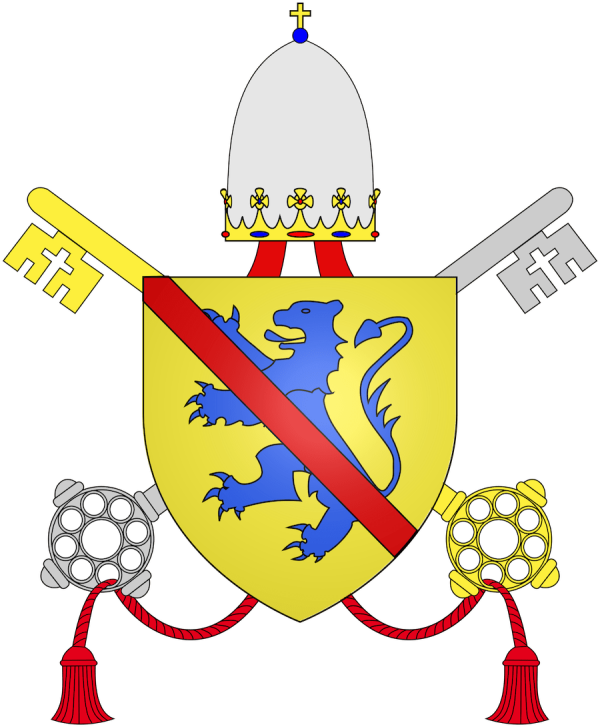
Pope Saint Celestine V was born Pietro Angelerio around 1215. He was the 12th of 15 children born to Angelo Angelario and Maria Leone in Campobasso. Pietro grew up in the mountainous region on the east coast of the peninsula of Italy. When Angelo died, Pietro was still a child. Due to their poverty, little Pietro had to go to work in the fields. His mother encouraged her children to become saints. The young man was intelligent, loving, and ascetic. He loved solitude. A natural at contemplation, at 17, he joined the Benedictine Order.
By his early 20s, Pietro retired to a solitary cave in the mountains of central Italy called Montagne del Morrone. Hence, he was called Pietro Morrone. Five years later, Pietro and two others left Morrone and moved to a more remote Majella Mountain in Abruzzi. At this point, he trained himself to live an extreme penitential style. Many men joined him in this lifestyle, forming a religious community which was approved in 1264. They later took on the name ‘the Celestines’.
In 1274, the Council of Lyons issued a directive to stop the formation of new orders. Pietro went to Lyons and convinced Pope Gregory X to uphold his ten-year-old order by connecting it with the Benedictines. He organized it to be a new, more severe version. Eventually, the Celestines grew to 36 monasteries and 600 monks before he died. When Pietro saw that the order had become mature, he turned the control to a man named Robert and retired to Majella for solitary penance and prayer. But, as he aged, he returned to the more accessible Morrone.
In April, 1292, Pope Nicholas IV died. The eleven cardinals met in Perugia for the conclave. But after two years, there still was no pope. Pietro, having followed the news, wrote to them warning that divine vengeance would fall on them, if they did not quickly elect a pope. It is said that the dean of cardinals, Latino Malbranca, cried out “In the name of the Father, the Son and the Holy Spirit, I elect brother Pietro di Morrone!” The cardinals voted him into office.
THE PAPACY
The conclave sent for Pietro, but he refused to appear and even attempted to flee Morrone. Shockingly, a deputation of King Charles of Naples, his son Charles Martel and several cardinals arrived, who persuaded him to accept the vote of the cardinals. In Aquila, Abruzzi, Pietro took the crown and the name Pope Celestine V. 200,000 people were said to have attended the coronation.
One of the first actions by the new pope was a papal bull granting a rare plenary indulgence to all pilgrims visiting the Church of Santa Maria di Collemaggio, where he had been crowned, on the anniversary of his coronation. The Celestine Forgiveness Festival is still celebrated there August 28 and 29 every year. This predated and set a precedent for the Jubilee Years which his predecessor began.
His other large action was appointing eleven new cardinals, bringing the number to twenty-two.
Unfortunately, every good holy man is not a leader. Celestine was an especially weak and ineffectual man. He distrusted the cardinals and stayed under the power of King Charles at Naples. This new pope appointed the king’s favorites to Church offices, but, being somewhat confused, sometimes several men to one office. He also favored his monks. Within months, Celestine realized his lack of authority and personal incompatibility for the position.
On 13 December 1294, Pope Celestine exercised his right of resignation. Then he planned to leave Naples, most likely to go back to Morrone. On Christmas Eve, Cardinal Benedetto Caetini became the new pope.
However, the new Pope Boniface VIII worried that Pietro Morrone would be turned into an antipope by Boniface’s enemies. Boniface ordered the elderly ex-pope to accompany him to Rome. Pietro must have guessed Boniface’s plan because he managed to escape from the group and succeeded in hiding in the woods for some time. The pope’s men hunted him down. They found him at the eastern seacoast where he had attempted to escape by ship to Dalmatia. Imprisoned by Boniface’s men, he lived in Fumone Castle in Lazio where he lived about nine months before dying 19 May 1296.
King Philip IV of France nominated Celestine for sainthood. Pope Clement V granted the canonization in 1313. Pietro Morrone, the sainted pope, is the patron of bookbinders, papal resignations as well as Aquila, Urbino and Molise, Italy.
Pope Saint Celestine V pray for us.
External links: POPE SAINT CELESTINE V, THE FIRST POPE TO VOLUNTARILY ABDICATE (catholic365.com)
Internal links: Pope Nicholas IV, the First Franciscan Pope – Lanternarius Press

Recent Comments